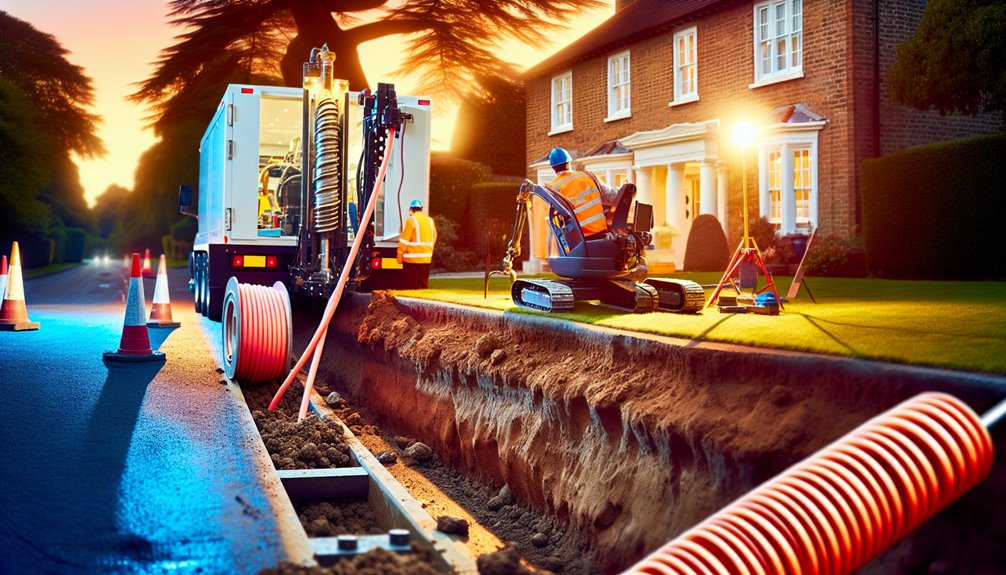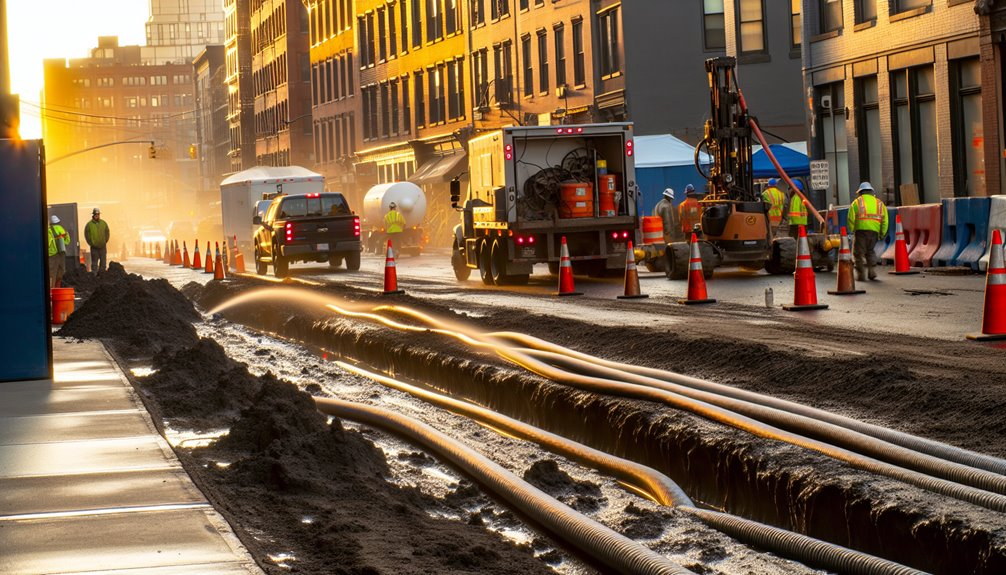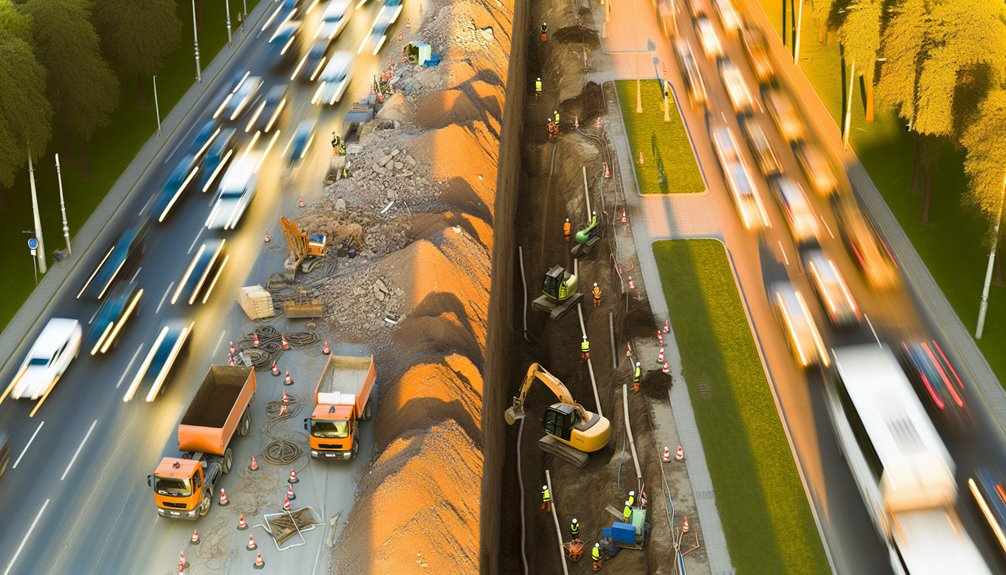You’re likely weighing auger boring against HDD on a tight residential site with grade-critical sewers, shallow cover, and congested utilities. Start by mapping tolerance zones, utility conflicts, and access limits, then assign auger boring to runs where slope control is non‑negotiable and HDD to steer under roots, patios, or unknowns. Plan pits, shoring, fluid containment, and survey controls as a single system. Calibrate gear, brief crews daily, and verify locates—because the sequence you choose next matters.
When to Choose a Hybrid Trenchless Strategy

Start by weighing site constraints against performance goals to decide if a hybrid of auger boring and directional drilling is warranted. You’ll assess soil profiles, utility congestion, setback limits, and entry/exit windows. Define tolerances for cover, separation, and curvature. If HDD alone risks frac-outs or conflicts, and auger boring alone limits reach or steering, a hybrid reduces exposure.
Model alignment timing with utility locates, permits, and crew availability. Sequence pits, tool changes, and fluid management so hybrid logistics don’t inflate risk. Verify bore path clearances, pullback forces, and annular pressures against manufacturer data. Plan contingency exits and stop-work thresholds. Standardize communication: daily briefings, redline updates, and shared QA checklists. When the plan cuts disturbance, controls loss circulation, and safeguards neighbors, choose the hybrid.
Aligning Grade-Critical Runs With Auger Boring
Although HDD can hold tight tolerances in skilled hands, you’ll rely on auger boring for grade-critical sewer and storm laterals because its cased, guided advance controls elevation and slope.
You start with a precise benchmark and laser target, then set the bore frame to the designed invert.
Verify thrust bed stability, casing alignment, and cutting head concentricity before launch.
During push, maintain steady rotation and advance to prevent heave.
Perform grade verification at each casing joint using the target, recorded offsets, and crew call-backs.
Adjust with shimmed jacking shoes, not improvised wedges.
Plan slope changes over adequate run length to avoid ponding or scouring.
Lock out utilities, ventilate pits, and shore excavations.
Document as-builts immediately so the whole team stays synchronized and accountable.
Using HDD to Navigate Obstacles and Tight Access

With grade-critical runs handled by auger boring, you turn to HDD when the route threads under roots, patios, retaining walls, or congested utilities and access is tight.
You stage a compact rig, verify clearances with multiple passes of locating, and establish a shallow entry to control bend limits.
Tight radius HDD lets you curve beneath obstacles while holding design depth and separation.
You select a steerable bit and matched reamers, calculate allowable bend per rod, and log every correction.
You manage drilling fluid with low-flow tooling, weighted to maintain bore stability and prevent breakout.
Using access minimizing HDD practices, you fence off work zones, pad hoses, and protect landscaping.
You pull product with a calibrated swivel, confirming tension stays within spec.
Planning and Permitting in Congested Utility Corridors
Before you mobilize, build a utility-aware plan that aligns design intent with permitting constraints in the corridor. Start with current utility maps, field-verify conflicts, and document clearances. You’ll reduce risk, shorten review cycles, and show agencies you respect shared right-of-way. Practice disciplined stakeholder coordination so neighbors, franchise utilities, and inspectors see you as a reliable partner.
- Compile utility maps, as-builts, and 811 locates; ground-truth with potholing and CCTV where feasible.
- Define alignment, depth envelopes, and tolerances; demonstrate separation from gas, power, fiber, and sewer laterals.
- Prepare permit submittals: profiles, traffic control, spoil handling, dewatering, and contingency routes for unknowns.
- Schedule stakeholder coordination meetings; agree on outage windows, inspection hold points, and notification protocols.
Track approvals, log variances, and update plans before cutting ground.
Equipment Pairings and Crew Configurations That Work

Because equipment dictates pace and tolerances, match your auger boring or HDD rig to soil class, bore length, and utility separations, then staff the crew to control every variable. Pair a mid-force HDD with modular tooling for quick bit changes, and a compact auger boring machine for straight shots under driveways. Add a portable vibratory compactor for sleeves and tie-ins without overexcavation.
Build a tight crew: a superintendent who owns the plan, an operator per rig, a locator with redundancy, a pipe handler, and two laborers trained for confined-entry and trench support. Assign a tooling tech to pre-stage cutters, reamers, and swivels, verify torque thresholds, and inspect threads. Standardize hand signals, radio checks, lockout procedures, and stop-work authority. You’re part of a team that finishes clean and safe.
Soil Assessment, Pit Design, and Fluid Management
Although small in footprint, residential bores demand the same rigor as municipal work: start by characterizing the soil and groundwater so your pit geometry, shoring, and drilling fluid plan match real conditions.
Log Soil stratigraphy, blow counts, and moisture to anticipate raveling sands, swelling clays, or cobbles.
Size launch and reception pits for safe pipe handling, spoil separation, and egress; design shoring to OSHA tables, not guesswork.
Match Dewatering methods—well points, sump pumps, or eductor systems—to hydraulic gradients, preventing base heave and wall instability.
Calibrate fluid rheology to formation: low-yield gels for sands, inhibitive polymers for clays, and controlled density to limit losses.
- Confirm utility clearances and setback constraints.
- Bench test fluid viscosity and filtration.
- Monitor pit inflow and wall movement.
- Stage containment, recycle, and disposal.
Sequencing, Survey, and Quality Control for Precision

Even on a short residential run, you sequence the work to control risk and tolerance: validate survey control, establish a fixed datum, and lock in alignment and grade targets before a bucket touches soil. You set control benchmarks at entry, exit, and intermediate offsets, then confirm them with independent shots. Calibrate locators, levels, and lasers, and document verification procedures so everyone reads the same numbers.
You stake HDD and auger boring centerlines, mark conflict zones, and define allowable deviation. Before cutting, run a dry walkthrough: utility locates, pit limits, spoil paths, egress, and exclusion areas. During drilling, log depth, pitch, and torque at defined intervals; during auger boring, record line/grade against benchmarks. You pause for hold-point inspections, reconcile readings, and correct drift immediately to protect safety, neighbors, and final tolerance.
Cost, Risk, and Schedule Optimization Techniques
Before you mobilize, build a baseline that ties scope, means, and constraints to measurable targets for cost, risk, and time. Use earned value to track variance, and adjust crews, shifts, or tooling before drift becomes rework. Align auger boring and HDD windows to utility clearances, access, and inspection hold points. Budget phasing and contingency modeling keep the plan resilient and the team aligned.
- Map risks by segment: ground loss, utility strike, frac-out. Assign triggers, controls, and cost/time impacts.
- Optimize sequence with takt planning; lock delivery cadences for pipe, bentonite, spoils, and surveys.
- Apply budget phasing to fund long-lead items early; tie releases to milestone gates.
- Use contingency modeling to simulate delays, right-size float, and preapprove escalation paths.
Conclusion
As the owner of Boring Bros., I’ve seen how pairing auger boring for grade-critical laterals with HDD for obstacle navigation gives us the best of both worlds — precise elevation control, utility protection, and yards left intact. We focus on planning pits, verifying marks, and calibrating tooling to hit slope tolerances while steering under roots, patios, and services. Our crews standardize daily briefs, fluid and survey checks, and design shoring and spoils handling to suit the soils. By sequencing shots, documenting as-builts, and monitoring returns, we manage risk and keep projects on schedule. If you’d like to learn more, please visit boringbro.com or give us a call at (954) 639-6167 — we’d love to talk about your project.




